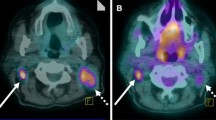Abstract
Over the past decades, Positron Emission Tomography has opened a new field of imaging. Nowadays, this technique is being used for diagnosing, staging disease as well as for prognostic stratification and monitoring therapy. In this respect, [18F]fluorodeoxyglucose (FdGlc) is by far the most commonly used PET agent. Many factors have been identified being responsible for a high uptake of this agent in malignancy. However, additional factors such as tumour treatment may interfere with the uptake mechanism. Knowledge of all these factors is a prerequisite for an optimal interpretation of PET studies and, consequently, for a reliable judgement of tumour status. In this article, a review is given of the factors influencing FdGlc uptake and the implications for clinical studies.
Similar content being viewed by others
Author information
Authors and Affiliations
Additional information
Received: 19 November 1999 / Accepted: 1 February 2000
Rights and permissions
About this article
Cite this article
Pauwels, E., Sturm, E., Bombardieri, E. et al. Positron-emission tomography with [18F]fluorodeoxyglucose . J Cancer Res Clin Oncol 126, 549–559 (2000). https://doi.org/10.1007/PL00008465
Issue Date:
DOI: https://doi.org/10.1007/PL00008465




